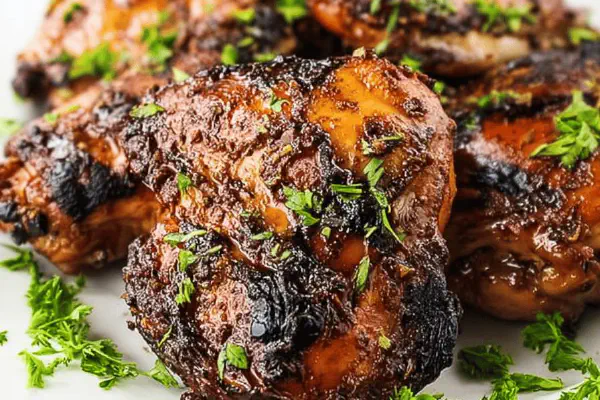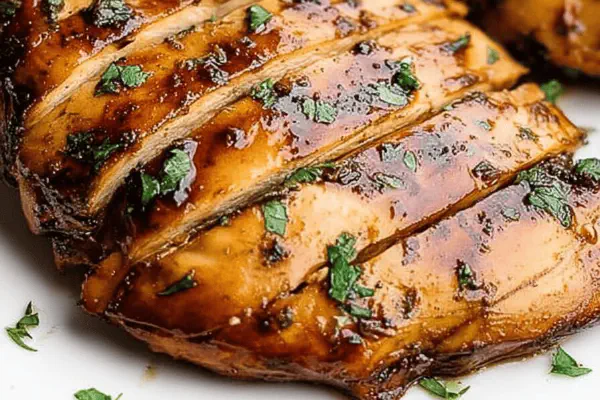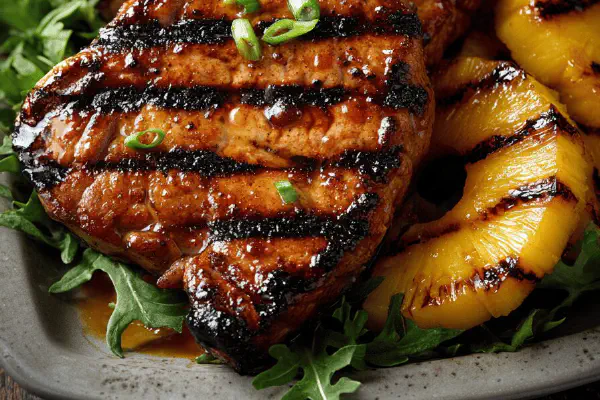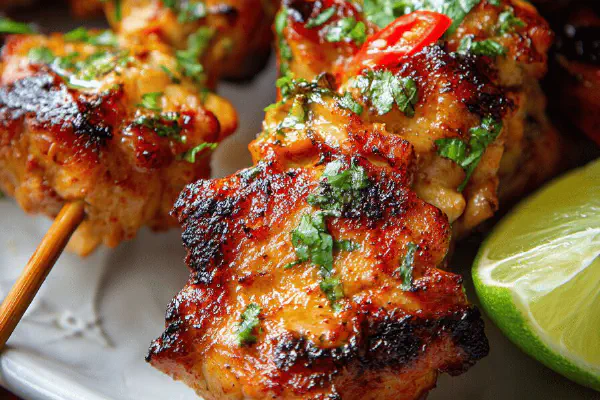Balsamic Rosemary Chicken

By Emma
Certified Culinary Professional
Ingredients
- 1/3 cup balsamic vinegar
- 1/2 cup water
- 1/3 cup olive oil
- 1/3 cup light brown sugar
- 3 cloves garlic minced
- 1 tablespoon fresh thyme minced
- 1/2 teaspoon ground black pepper
- 1/2 teaspoon coarse sea salt
- 1.5 pounds boneless skinless chicken breasts
About the ingredients
Method
- Whisk vinegar water olive oil brown sugar minced garlic thyme pepper salt in medium bowl until sugar dissolves fully. Let rest minute or two to marry flavors. Sharp tang softened by the sugar pool; don’t skip.
- Trim chicken clean of any visible fat or tendons, pat dry good with paper towels—if chicken’s too wet marinade slips off and you won't get that sticking glaze caramel. Shiny dry surface helps browning. Place breasts in a shallow baking dish.
- Pour marinade over chicken, flip and baste each piece several times making sure every inch wears glaze jacket. It’ll be slippery but that gloss is what sears up best on grill. Let sit 10 minutes max if time tight—too long and the acid starts cooking protein, toughening skinless meat.
- Preheat grill to medium-high near 350°F. Oil grates well, use oil on paper towel held with tongs then swipe. Avoid dripping oil on charcoal or flames; flare-ups char sauce nasty. Setup indirect heat zone: coal or burners off on one side, chicken on off side without flame stroke.
- Place chicken over indirect heat. Close lid. Look for sizzle sound. After 7-8 min flip gently using tongs. Chicken will start to firm, juices clearing at edges. Skinless cooks faster than you expect, so flip early and often to avoid drying.
- Cook total 22 minutes roughly, flipping once more halfway if chicken thick. Visual: when firm, no jiggly spots, and internal temp around 160-165°F when checked with probe thermometer inserted at thickest part, it’s done. Let rest 5 minutes after off grill, juices redistribute and flavor deepens.
- If lacking fresh herbs, dried thyme or oregano can sub but use half amount to avoid overpowering. No balsamic? Try apple cider vinegar but reduce water by slight margin to keep acidity balanced. Brown sugar could be swapped for honey but add after grill to avoid burn.
- Watch for dark glaze spots popping caramel bubbles on edges—that’s your cue to flip or move chicken. Glossy finish on surface signals good caramelization, a little rough char welcome but not ashes—scale heat or move chicken accordingly.
Cooking tips
Chef's notes
- 💡 Sugar must dissolve fully before marinade meets chicken. Gritty sugar ruins glaze caramel, uneven browning follows. Whisk thoroughly, no shortcuts here. Rest marinade few minutes to marry flavors; sharper tang softens then.
- 💡 Pat chicken bone dry or glaze won’t stick and slips off easily, no grip means poor caramel. Paper towel essential. Wet chicken frustrates searing and browning, don’t skip drying step even if impatient. Helps crisp edges form faster.
- 💡 Oil grill grates hot enough to sizzle water droplets on contact. Use paper towel with tongs to avoid flare-ups and grease fires. Direct open flame burns glaze fast; indirect heat is slow crust, tender inside without black nasty bits.
- 💡 Flip chicken early and often; skinless dries fast. Gentle touch with tongs stops juice from spilling. No fork, no stab. Tactile feedback beats timers every time. Feel firmness, bounce before checking thermometer. Timing changes with thickness and heat zones.
- 💡 Watch for popping bubbling glaze edges, shiny dark spots mean sugars caramelizing right. Move chicken if flames flare or edges burn. Glossy outside means sticky, nearly done. Let rest loosely covered after off grill; juices redistribute, flavor deepens.
Common questions
Can I substitute herbs?
Thyme swapped rosemary here but use half rosemary if reversing. Dried herbs fine but halve quantity. Oregano works too but alters flavor profile more. Fresh best but not must-have.
What if no balsamic vinegar?
Apple cider vinegar works but reduce water slightly to keep acid balance. White wine vinegar possible but less robust. Avoid straight vinegar on chicken long time or meat tightens and dries after cooking.
How to prevent sticking or flare-ups?
Dry chicken coated oil before grilling. Oil grates well done before cooking. Avoid dripping oil on flames; can cause flare-ups, char sauces bitter. Move chicken if flare-ups appear. Use indirect heat zone always.
How to store leftovers?
Cool quickly then fridge covered few days. Reheat gently to avoid drying out; microwave with lid or pan with splash water best. Freeze okay wrapped tight; thaw overnight in fridge before grilling again or reheating.



